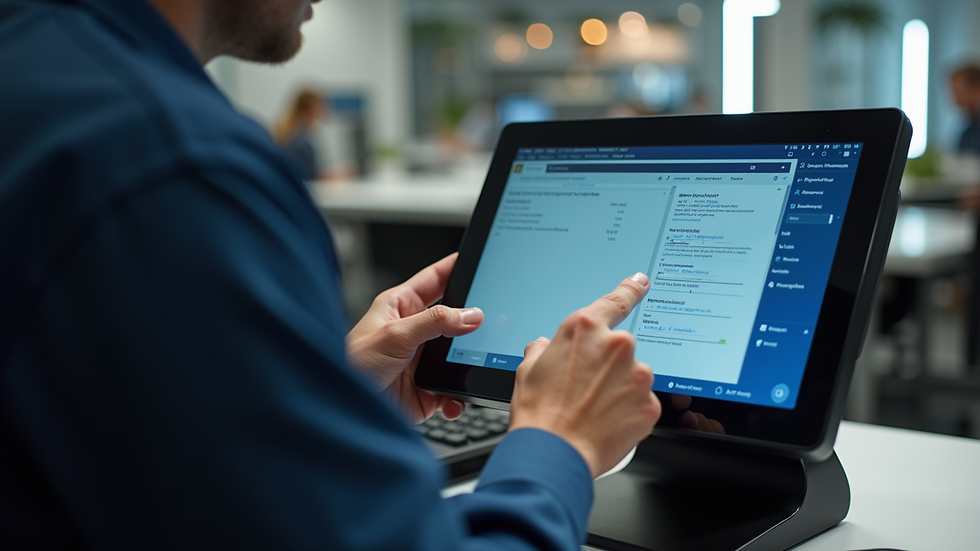Common Tech Issues in POS Systems and How to Fix Them
- Teboho Daniel

- Jun 23
- 4 min read
Point of Sale (POS) systems are essential tools for retail and business operations. They streamline transactions, manage inventory, and improve customer service. However, like any technology, they come with their own set of challenges. In this blog post, we will tackle some of the most common POS system issues, along with practical solutions for fixing them.
Common POS System Issues
Understanding the common issues faced by POS systems is the first step to ensuring seamless operation. Below are some typical problems that users encounter:
Hardware Malfunctions: From printers to card readers, hardware issues can disrupt business processes. Common malfunctions include jammed receipt printers, faulty barcode scanners, or malfunctioning cash drawers.
Software Bugs: Software glitches can lead to various issues, such as system crashes, slow performance, or incorrect transaction processing. It is crucial to keep your software up to date to minimize such risks.
Network Connectivity: Many POS systems rely on internet connectivity. Loss of connectivity can render your system unusable, preventing sales and frustrating customers.
User Error: Sometimes, the problems start from improper use of the system. Mistakes in data entry or misunderstandings of the system's features are common.
Integration Issues: In a multi-function environment, integrating your POS system with other software, like accounting or inventory management, can lead to discrepancies or software conflicts.

Diagnosing the Problem
Identifying the root cause of these issues is vital. Here are some steps to diagnose problems effectively:
System Logs: Most POS systems generate logs. Check these logs for error messages or warnings related to your current issue.
Replicate the Problem: If possible, attempt to replicate the issue. This helps determine whether it's a consistent problem or an isolated incident.
Consult User Manuals: TillSense manuals enriched with troubleshooting guides. Reference these guides to see if they contain any information related to your issues.
Contact Technical Support: In some cases, reaching out to TillSense technical support team is necessary. Be ready to provide us with specifics about the issue you are experiencing.
Ask for User Feedback: If multiple users are experiencing similar issues, gather feedback from them. This can help pinpoint whether the problem is from the system or user-related.

How do I fix my POS problem?
Once you’ve identified the problem, the next step is to implement a solution. Here are some common fixes for typical issues:
Repairing Hardware Malfunctions:
Receipt Printer: If the receipt printer is jammed, turn it off, and carefully remove any stuck paper. Ensure that you are using the correct type of paper.
Card Readers: If your card reader is not functioning, check the connections and reset the device before attempting a replacement.
Resolving Software Bugs:
Install Updates: Regularly check for updates from your software provider and install them. These updates often contain bug fixes and feature enhancements.
Reboot the System: Sometimes, a simple restart can clear glitches.
Restoring Network Connectivity:
Check Internet Connection: Ensure your internet is working fine. Restarting your router and modem can often resolve connection issues.
Use Backup Systems: If your POS system has an offline mode, ensure it is enabled so you can still make sales during outages.
Training Staff on Proper Use:
Conduct Workshops: Regular training sessions and workshops can equip your staff to use the POS system effectively.
Create Easy-to-Follow Guides: Develop quick-reference guides to assist users with common functions.
Simplifying Integrations:
Check Compatibility: Ensure that all integrated systems are compatible with your POS. If necessary, consult with your vendors for improved versions or alternatives.
Test Integrations Before Full Launch: Always conduct test runs of integrations to identify potential issues before they affect your operations.

Importance of Regular Maintenance
Regular maintenance can prevent many issues from occurring. Here’s why you should prioritize it:
Enhances System Longevity: Well-maintained systems last longer, saving you money over time.
Boosts Performance: Regular maintenance helps keep your system running efficiently, thereby improving transaction speeds.
Prevents Unwanted Downtime: Proactive maintenance can prevent incidents that would result in downtime, affecting customer satisfaction and sales.
Carry out the following maintenance routines:
Schedule Regular Updates: Automate software updates where possible to ensure that your POS system always operates on the latest version.
Backup Data: Regularly back up your data to prevent loss in case of hardware failure or cyber attacks.
Run Diagnostic Tests: Many systems offer diagnostic tools that can help you assess the overall health of your POS system.
Inspect Hardware: Regularly inspect hardware components and clean them to ensure stable performance. Dust buildup can lead to overheating and failures.
Final Thoughts
Maintaining a POS system can seem daunting, especially when issues arise. However, by familiarizing yourself with common problems and their solutions, you can significantly improve your system's reliability and efficiency. Ensure you engage in pos system troubleshooting as needed, and maintain a proactive approach to maintenance and team training. This way, you can focus on what matters most—serving your customers and growing your business.
If you encounter persistent issues, don’t hesitate to reach out to TillSense experts for help. Keeping your POS systems running smoothly will help provide a better experience for both you and your customers.




Comments